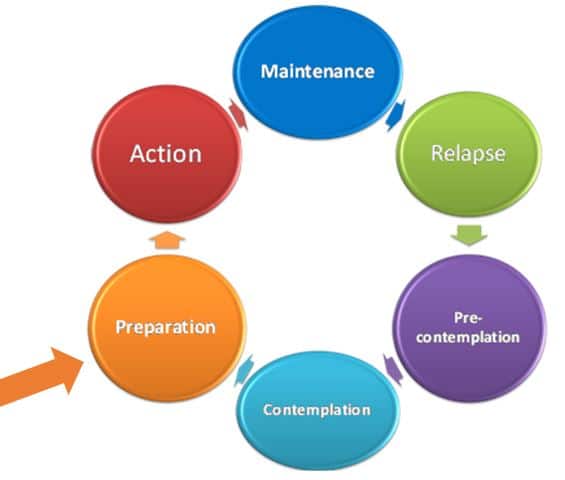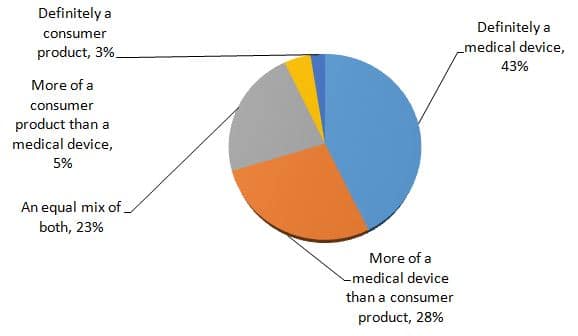“Peeling the Onion” is a monthly column by Harvey Abrams, PhD.
In my last post, we took a little side-trip (a path less-traveled) from John’s Journey to explore the Case of the Curious CDC report on the “Prevalence of Disability and Disability Type among Adults – United States, 2013.” This week, we’ll get back on our main path and discuss the next stage in John’s Journey – Preparation – and how the MT9 data can inform us regarding the dynamics associated with this stage and their implications for better hearing and quality of life.
Models of Belief and Change
Recall that the Transtheoretical (changes of change) Model consists of 6 stages (Figure 1):
- pre-contemplation
- contemplation
- preparation
- action
- maintenance
- relapse
John has contemplated the risks vs benefits associated with taking action as described by the Health Belief Model and is now entering the Preparation stage. Here the individual is ready to take action in the near future (perhaps within the next month). John may have consulted with his physician, made inquiries among friends or conducted on-line searches.
Data Informs the Preparation Path
MT9 provides us with data that reveal where John, as a non-hearing aid owner, is likely to look for information in preparation of taking a specific action. Table 2 reveals that the most common source of information is clearly the internet.
As a matter of fact, internet or online information is accessed 3 times more (74%) than the next source of information for non-owners – brochures or other printed information (at 24%) that are left at other establishments such as doctor offices or senior living facilities, for example. John is considerably less likely to get information from print ads or direct mail (19%) or informational sessions provided by a clinician or “consultant” (12%).
What the data don’t tell us, of course, is whether or not any particular source of information directly leads to a purchase. It’s entirely possible that bringing a consultant into your practice for a couple of days as part of an ‘open house’ yields a higher rate of hearing aid purchases than other forms of marketing, including an online presence, resulting in a higher return on investment for the consultant option.
It’s also interesting to explore what type of information John is looking for when he is preparing to take action. It may come as a surprise to some that as a non-hearing aid owner, John is not necessarily looking for hearing aid-specific information. As shown in Table 2, the MT9 data revealed that 55% of the non-owners surveyed were most interested in acquiring general information about hearing loss.
Aligning Marketing Strategies with John’s Journey
Remember, the Stages of Change model doesn’t suggest that John must complete one stage before moving to the next. In all likelihood, John is still contemplating the benefits of taking action against the risks of doing nothing. Obtaining information about his symptoms and treatment options becomes part of the data base upon which John will ultimately make a decision. Following a search for general information (55%), seeking specific information on the types, styles, features, price, etc. of hearing aids comes in 2nd (36%). Pursuing information about specific hearing care providers comes in at 18% and toward the bottom of list is looking for information on a particular hearing aid brand (15%).
In aggregate, these data seem to point to some marketing strategy possibilities: make sure your practice has a very visible online presence but bring folks to your practice website via online information about hearing loss and its treatment (including hearing aids and alternatives to hearing aids). Once they’ve entered your practice website, impress them with your experience and credentials, not necessarily with the brand names of hearing aids you carry.
There’s another MT9 data point that answers a particularly important question: How does John think of hearing aids – as a medical device or a consumer device? Figure 2 provides some insight into that question.
About 70% of the MT9 respondents considered hearing aids more of a medical than a consumer product (at the very least). If we include those who think of hearing aids as a medical device and consumer product equally, the percentage goes up to over 90%.
The point here is that if John considers hearing aids a consumer product (i.e. a commodity) he will go shopping (perhaps online) for the lowest priced device; if on the other hand, he thinks of hearing aids as a medical device he will likely be coming to you. More about that part of the journey next time.
Harvey Abrams, PhD, is a principal research audiologist in the hearing aid industry. Dr. Abrams has served in various clinical, research, and administrative capacities in the industry, the Department of Veterans Affairs and the Department of Defense. Dr. Abrams received his master’s and doctoral degrees from the University of Florida. His research has focused on treatment efficacy and improved quality of life associated with audiologic intervention. He has authored and co-authored several recent papers and book chapters and frequently lectures on post-fitting audiologic rehabilitation, outcome measures, health-related quality of life, and evidence-based audiologic practice. Dr. Abrams can be reached at harvey_abrams@starkey.com
This is Part 10 of the Peeling the Onion series. Click here for Part 1, Part 2, Part 3, Part 4,Part 5, Part 6, Part 7, Part 8, Part 9.
feature image by Ross Land/Getty











